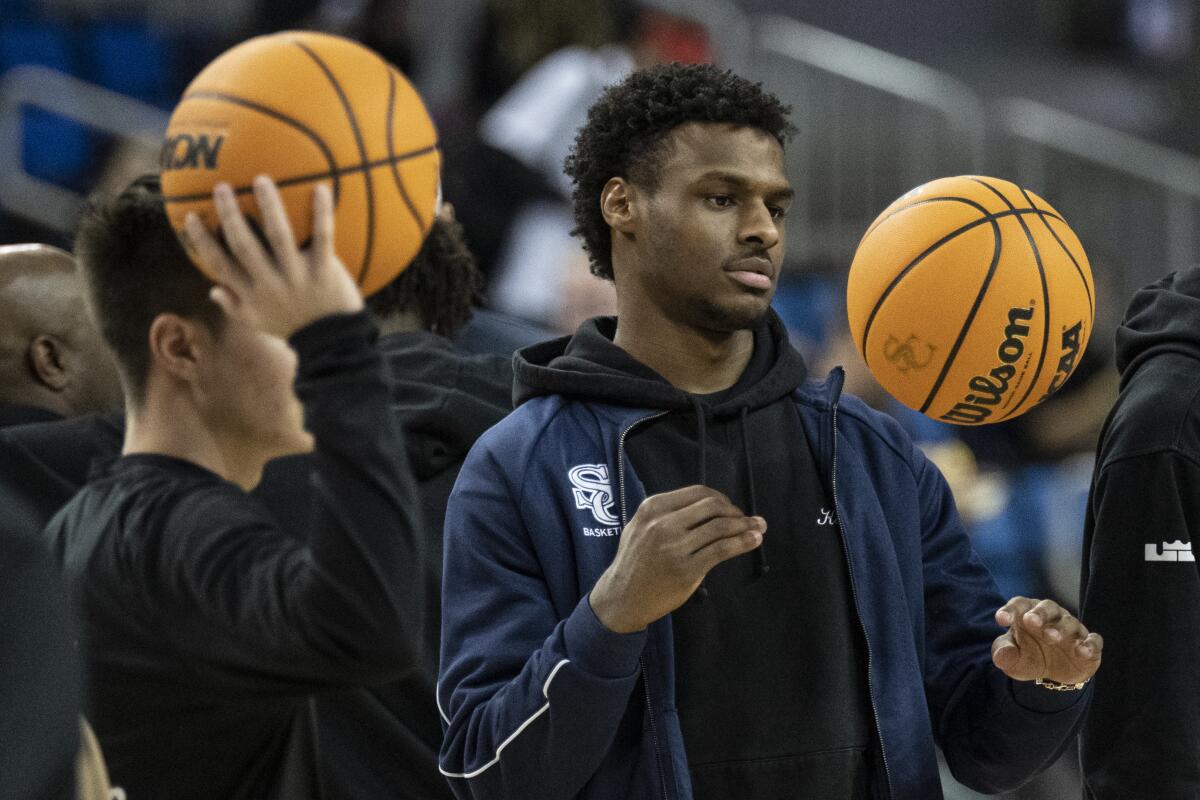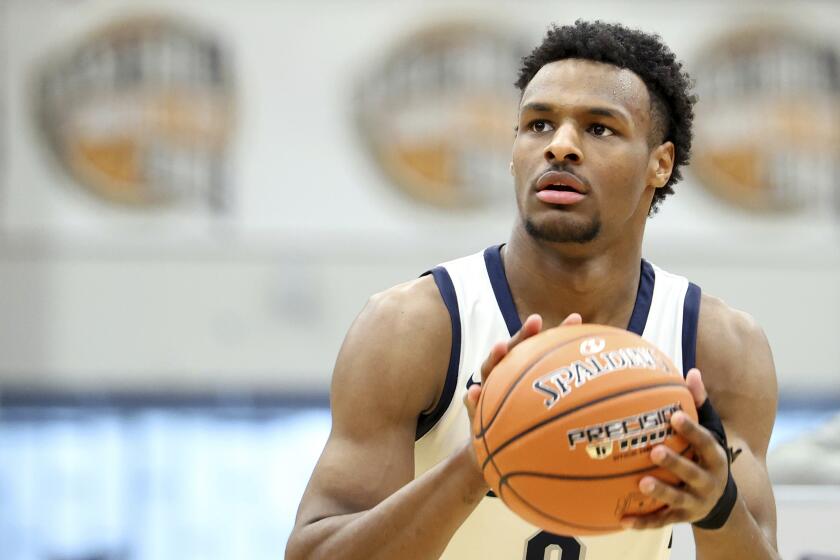In wake of Bronny James’ cardiac arrest, young athletes express concerns over health risks

- Share via
Doctors told Haley Jones she’d never play competitive sports again. That was the diagnosis she was faced with after she took a mandatory EKG test before her junior lacrosse season at Occidental College.
She was a healthy 20-year-old who grew up swimming, running cross-country, playing volleyball, basketball, lacrosse, and soccer, as well as doing gymnastics and dance. But it turned out that the genetic condition long QT syndrome had been affecting the electric current in her heart, silently, since she was born. And the new sports health screening protocol caught it.
“Essentially, I was told if I didn’t do this test, I could have died at any second in any of the sports or workouts or anything I’d ever done,” the 23-year-old Jones said Tuesday. “A very surreal moment for me.”
As the news of USC freshman Bronny James suffering cardiac arrest at practice Monday spread, former and current collegiate athletes in Southern California expressed concern — and in Jones’ case, hyperawareness — about the health risks involved in playing sports.
Sudden cardiac arrest is rare, but still the leading cause of death during exercise among NCAA athletes, according to University of Washington researchers. Seventy-five percent of all sudden deaths that occur while these athletes are playing sports are attributable to cardiovascular conditions, according to Dr. Satyajit Reddy, a sports cardiologist with the Mayo Clinic in Phoenix.
College athletes ought to be some of the fittest people around. So what would cause a young, healthy person to suffer sudden cardiac arrest?
James’ cardiac arrest was USC basketball’s second in two years after Vince Iwuchukwu, a freshman at the time, collapsed in 2022. Basketball players are at the highest risk, according to a 2016 study.
Monitoring the condition properly was critical for Jones, who was able to compete during her senior lacrosse season after being put on beta blockers, undergoing more testing, and creating a resuscitation plan with her college athletic staff.
“Everyone was aware that should I faint or should I have an issue, you have those two precious minutes to get to me and to use the defibrillator,” she said.
Other collegiate athletes, like former Claremont-Mudd-Scripps basketball player Kiran Kruse, had not fully considered the full scope of risks involved with cardiac arrest in sports.
“It’s obviously a scary thing when you have these athletes who are some of the best athletes on the planet just kind of dropping in the middle of practice and games in a life-threatening situation,” Kruse said.
“I can’t even imagine what I would do if that happened in one of our practices,” he added. That was never something that even crossed my mind.”
When Bronny James suffered cardiac arrest during a USC basketball workout, the staff drew on its experience treating Vince Iwuchukwu’s cardiac arrest.
Kruse retired from college basketball with crunchy joints and “things that hurt probably more than they should at 22” — the kinds of physical injuries athletes expect to endure in their careers.
The news of James’ sudden cardiac arrest is what made University of La Verne swimmer Asher Kocalis aware of how big a risk SCA was in sports. He was not concerned about his own risk due to the aerobic benefits of swimming.
“But even in swimming,” the 21-year-old Kocalis said, “I’m scared for other people, because you’ll see people getting ready for their race by ... downing really highly caffeinated drinks.”
Caffeine overdoses can cause primary cardiac arrests in the form of ventricular fibrillation, which is different from sudden cardiac arrest.
Kocalis, who also works as a swim coach at the Scheu Family YMCA in Upland, worries about his high school and middle school swimmers coming into practice with caffeinated drinks rather than water. Once, a swimmer brought a Monster energy drink. He talked to him and the swimmer brought tea next time.
Another collegiate swimmer, Cole Goyette of the University of Redlands, said his team has been discussing an incident earlier this month in Columbus, Ohio, where a 14-year-old had a cardiac event in the water during a swim meet.
While the 19-year-old Goyette said he hasn’t worried about his cardiac health, he hopes the recent events will make the athletic community at large rethink its awareness of health conditions.

As the conversations around cardiac health risks in college athletics grow, what are next steps for the athletes?
“I think it’s just really important to be aware with your body,” Jones said. “And even if you feel able bodied and healthy to make sure that you are having those yearly checkups. ...
“Because as we’re seeing an increase in health issues within athletes, whether professional or collegiate, you never know when that could be you and I guarantee anybody in an emergency situation would say, if you could ask them, they had no idea it would be them.
“And I have that same feeling. I never thought it would be me.”
More to Read
Go beyond the scoreboard
Get the latest on L.A.'s teams in the daily Sports Report newsletter.
You may occasionally receive promotional content from the Los Angeles Times.













